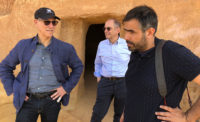“It’s just a part of an architect’s work, but I do turn down a lot of this stuff,” Frank Gehry, FAIA, says of product-design commissions. When the French shoemaker J.M. Weston approached the Los Angeles–based architect to collaborate on a limited-edition shoe in early 2008, it was Gehry’s family members who wouldn’t take no for an answer. His son, the artist Alejandro Gehry, admits to a long-held interest in shoe design. “Alejandro’s mother, my wife, is Mrs. Imelda. She has a shoe collection,” the elder Gehry also notes, trailing off. “Both of us got tons of approval for doing this project.”
J.M. Weston unveiled the results of the father-and-son collaboration in May. The Gehrys conceived an oxford-based monochromatic boot featuring a row of four leather-covered buttons, as well as a two-tone, six-button boot that refers to the 19th-century balmoral design invented for Prince Albert.
Frank Gehry—who also has designed jewelry for Tiffany & Co.—notes an affinity between shoes and his legend-making profession. “Shoes are very architectural and always have been,” he says, “and even more recently there are new shoes like Miuccia [Prada’s]—they’re buildings.”
Not coincidentally, famous architects and their next of kin have clad our feet before. In a 1944 Museum of Modern Art exhibit inspired by his book Are Clothes Modern, architect Bernard Rudofsky introduced the sandal designs that would launch he and his wife Berta’s sandal company Bernardo in 1947. Fifty-one years later Ito Morabito, nephew of French architect Yves Bayard, made the leap from architectural to product design thanks to a project commissioned by stiletto inventor Roger Vivier. In 2003 Rem Koolhaas’s nephew Rem D. Koolhaas, an architect, cofounded the shoe company United Nude.
Like Gehry, Zaha Hadid is freshly indoctrinated into shoe design. Last year the Brazilian shoemaker Melissa introduced an eponymous high heel to the marketplace. And in July, Lacoste launched limited-edition, men’s and women’s leather boots by the architect, and the fashion house will begin selling more affordable versions this fall.
In all cases, Hadid’s work most clearly demonstrates a translation of architectural vision to tootsy scale. The Melissa shoe’s form, topped by asymmetrical straps, appears molded upward from a single block of warm wax. The Lacoste boot, meanwhile, evokes an alligator’s tail wending up the leg, for which Hadid’s design team appropriates rapid-prototyping technologies it usually deploys for model-making. Project architect Maria Araya says, “From shoes to master plans, it’s the same design process and language we’re trying to develop.” Woody Yao, an associate director in Hadid’s London studio, concurs: “In my 15 years with Zaha, a smaller project is like a testing field for the bigger scale.”
“You shouldn’t have to differentiate between disciplines,” Gehry says of phenomenon of architects taking on shoe-design commissions. John Storey, the Lacoste global publicity director who oversaw the Hadid project, says that, based on the company’s successes teaming with other designers outside of fashion, consumers can expect more architect crossovers.
Yet those collaborations may not be limited to celebrities. Annie Mohaupt is a Chicago-based footwear designer and manufacturer who worked in architecture for seven years prior to opening Mohop Shoes in 2005. She says that architecture “definitely influences how forms work in an efficient way,” and even uses materials from her former line of work, such as hospitality-grade faux leathers, in her collection. Mohaupt also notes that lately she’s been inundated with e-mails from architecture students assessing the job market. “Architecture offers really great preparation for all sorts of careers,” she says. “It’s nice to know you have options.”




Post a comment to this article
Report Abusive Comment